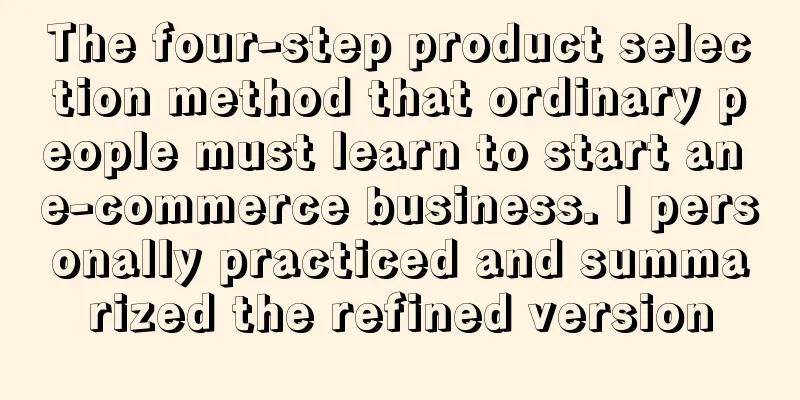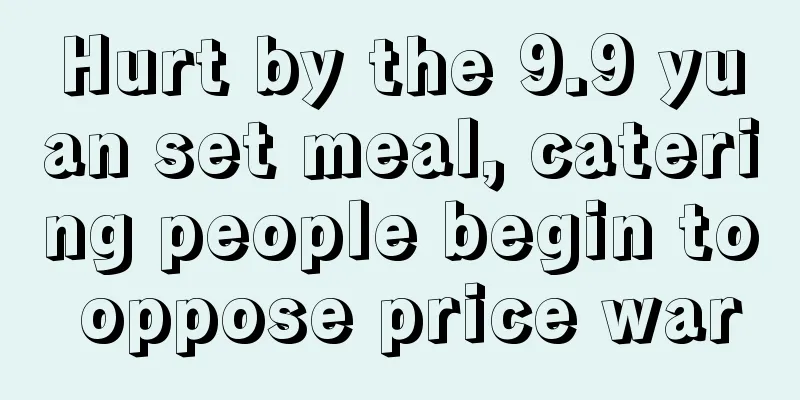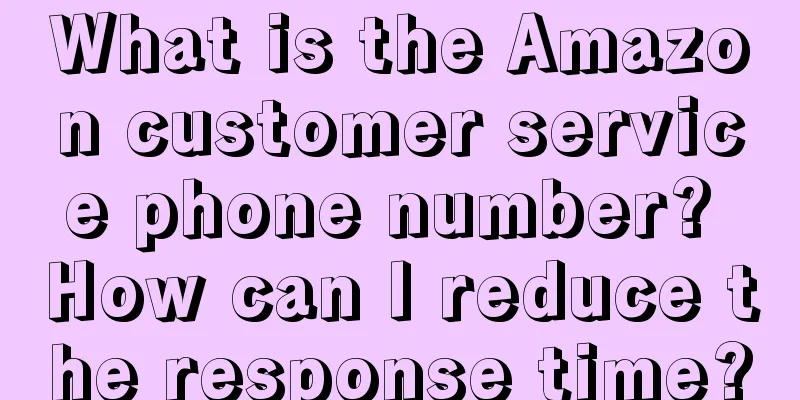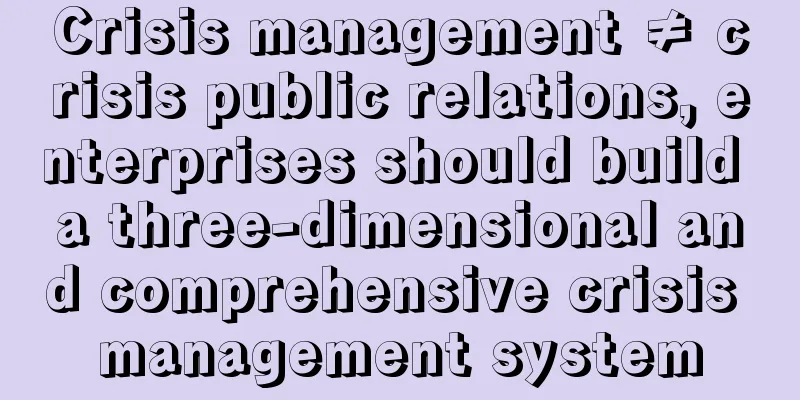The four-step product selection method that ordinary people must learn to start an e-commerce business. I personally practiced and summarized the refined version

After the previous article "Five Gates Ordinary People Must Cross in the Product Selection Stage When Starting an E-commerce Business" was published, it aroused enthusiastic response from readers. Many friends also added me through this article to consult me on some issues regarding product selection. Some friends also said that although this article pointed out the direction for everyone, they still felt confused about the actual implementation of product selection. They didn’t know how to implement it or whether the implementation was scientific. Today, I will personally share my own product selection method that has been put into practice and is very suitable for ordinary people, referred to as the [Four-step Product Selection Method]. With just four simple steps, we can quickly enter a category and complete the initial product selection. Well, here, I would like to make a special note: my four-step product selection method is more suitable for complete novices who know nothing about e-commerce and have no e-commerce experience. If you have strong e-commerce operation ability, self-media ability, rich experience, and strong promotion and category ability, then you don’t need to look at my method because it is too superficial and not suitable for you. Just like the "five doors" I mentioned in my previous article, your position at each door will determine your different understanding of e-commerce product selection. You are a rookie, so your understanding is bound to be superficial and simple; You are an expert and you have e-commerce experience, so you must have a deep understanding of product selection and it will have more dimensions. So it is more important for us to understand what stage we are in and choose the method that suits us best. The [four-step product selection method] that I will talk about today is suitable for ordinary people who know nothing about e-commerce. Let’s correct some misunderstandings first First of all, before introducing the method, I still want to correct some misunderstandings. The first misunderstanding is the product selection theory, thinking that choosing a great product means everything will be successful. This is a very immature idea for ordinary people who have never done e-commerce. In the context of the entire e-commerce business chain, the importance of product selection may only account for about 30%, and the remaining 70% includes vision, packaging, conversion, operation, delivery, supply chain, after-sales, and content, which are also very important. So there are some so-called hot-selling product selection strategies in the market, but I think they have no value for newbies. You follow the hot-selling products and if others sell hot-selling product A, you will also choose hot-selling product A. It is equivalent to completing 30% of the work, but you still don’t know how to do the remaining 70% of the work, and you still can’t sell it. More importantly, they chose Product A and successfully sold it through a series of operational means. Their entire idea from product selection to promotion is original, and it is done step by step using logic, practice, trial and error, and optimization, and they will gradually accumulate their own system of ideas. You know nothing. You just follow suit and sell whatever is popular among others. Without any practice, observation, and trial and error, your brain is unable to develop a true product selection mindset. You have only learned to follow the trend. So I suggest that you don’t have too high expectations for product selection at the beginning, but build up your own product selection ideas through practice as soon as possible. Even if this practice is immature and superficial, it is indeed something you have grown step by step from scratch. Let me add one more thing: when can we say that product selection is important and product selection determines everything? I think you have already come up with some promotional methods, some methods of attracting traffic, which can complete the initial conversion and delivery. When you can continuously and stably attract traffic and deliver, I think at this stage, we can once again emphasize the importance of product selection, because you have traffic and you know how to promote it, then you can concentrate on researching products, finding good products, and amplifying the potential energy of your traffic. Before this, it is meaningless to overemphasize the importance of product selection. The second misunderstanding is that the goals that are expected to be achieved through product selection in the initial stage are deviated. For us ordinary people, newbies, and friends who have never done e-commerce, the initial product selection is not for the purpose of selling a product well. Like I said before, if you don’t understand promotion, marketing, and packaging, how can you possibly sell your products well? This starting point is wrong. So be realistic and practical. I think it would be good if the initial product selection can achieve the following goals. The first thing is to quickly select products and quickly get into business execution. Don’t just daydream about it. Quickly complete product selection and move on to the next step. After entering the next stage through product selection, you will expose many problems, including visual, promotion, delivery and other problems. You need to solve these problems as soon as possible. If you always delay in selecting products and daydream, you will not see these problems later and solve them. The last step is to build a basic understanding framework for the product through initial product selection, begin to have an initial feel for the product, and get some feedback from the market. I think it would be great if you can achieve these goals in the early stages. You always think about whether the product you choose can sell well or whether it can sell in large quantities. These thoughts are meaningless. You don’t know anything about e-commerce operations. Even if you are given a hot-selling product, you won’t be able to sell it! It is better to focus on advancing the business first and then solve the problems step by step. Okay, then, let’s move on to the four-step product selection method for e-commerce that I carefully refined for ordinary people, e-commerce novices, and rookies. These four steps include: focusing, collecting, classifying, and directing. It’s very simple, even 8-year-old children say it’s good. The first step of the four-step product selection method 1. FocusWhat to focus on? Focus on a sub-category. I have said before that the word "selection" actually has two meanings, one is [selection of category], the other is [selection of product] Our focus is to focus on a sub-category. For example, if you want to sell men's backpacks and school bags, this is a large category. Because it includes business backpacks, laptop backpacks, programmer bags, travel bags, high school student backpacks, junior high school student backpacks, children's backpacks, girls' backpacks and many other subcategories. So this is a big category, and it’s very easy to understand. Women's clothing is also a large category, which includes many sub-categories such as pants, tops, dresses, shirts, etc. Beauty, food, etc. are all large categories. These major categories are all very large, and it is impossible for us newbies to work in all categories in the early stages, so we have to focus on a sub-category. Taking the large category of backpacks and school bags as an example, I took a look and decided to focus on the sub-category of children's school bags. I want to make children's backpacks, and the children's backpacks may be further divided into lower levels, but we won't do that. The category of children's backpacks is not very large, so it is enough to just land at this level. For example, a newcomer wants to sell women’s clothing (of course, I don’t recommend people who know nothing about e-commerce to sell women’s clothing in the early stages). There are many subcategories in women's clothing, such as pants, shirts, skirts, and dresses. Okay, I looked at it and decided to focus on pants, women's pants, and I focused on this sub-category. However, the category of women's pants is also relatively large, and is divided into jeans, casual pants, suit pants, shorts, etc. So I decided to focus on women's jeans and land on this sub-category. Okay, the first step has been completed, which is to focus on a more vertical category. Because the biggest problem encountered by newcomers in the initial product selection is: It’s not that there are too few products on the market, but that there are too many products. It’s easy for newbies to be confused after seeing too many products. So at this time, we must quickly define a scope and focus on one direction. In this way, we will not be trapped in the vast ocean of products. That's focus. Someone might ask, what logic should be relied on when landing in sub-categories? Should we do market analysis? Should we do data research? You don’t have to, just choose what you like. No matter how you analyze and research, it will be meaningless because you have no idea how the business will develop in the future. What you need now is quick decision-making, quick implementation, and quick progress. For a newbie like you, the so-called research and observation have no scientific basis at all. So as long as you see a sub-category that you like, that looks pleasing to the eye, and that you want to get involved in, then focus quickly. Isn’t it simple? Next we move on to the second step. Step 2 of the Four-Step Product Selection Method 2. CollectionLet’s continue to use children’s school bags as an example. After focusing on the children's schoolbag category, the next step is to collect 100 children's schoolbag products and prices on the e-commerce platform. How to collect? It's very simple. Just open the e-commerce platform and enter the words "children's schoolbag". You take screenshots of all the children's backpack products you see, make a list, and record their image styles and price ranges. Yes, collect whatever you see, without distinction. In the early stage, you only need to collect these two pieces of information. The picture style provides a reference for our subsequent product selection. The price band provides data support for subsequent pricing. How many should I collect? Just collect 100 of them, as shown in the picture. Some friends asked, why not collect the hot items? Why collect indiscriminately? 80% of the products you see after entering the search term on the e-commerce platform are hot-selling products, so under such a process, indiscriminate collection is sufficient. Of course, the more you collect, the more comprehensive your understanding and observation of this category will be, but I think 100 are enough. No matter how many more you collect, they are essentially repetitions of these 100. Isn’t it simple? Just don’t be lazy and collect products and prices. Next we move on to the third step. Step 3 of the Four-Step Product Selection Method 3. ClassificationAfter you have collected 100 children's backpacks, you can see with your naked eyes that these 100 products are of different types and styles. What we need to do next is to select a certain dimension for classification. There are many ways to classify this. You can choose based on your own feelings, cognition, and logic. There is no standard answer. It can be classified by style, size, function, scene, design and so on. I generally like to classify products based on their styles, because styles are easier to divide and more intuitive. For example, you can see these children's backpacks that I have collected. There are so many of them, and they are packed tightly together. But if you look closely, you will find that they have distinct styles. For example, there is a cute pet style, with kitten and puppy themes; For example, there is a simple style based on color blocks. For example, there is another type of schoolbag with a fresh and cute style; Through explicit product observation, I came up with a rough classification of products. You don’t have to worry about whether the classification is scientific or not. Our classification is the result of intuitive observation, which is scientific. Moreover, our whole process is to gain experience in practice, which must also be scientific. In short, don't worry too much about the initial product selection. Let’s take a few more categories, such as vases. We collected 100 vases, which seems to be a lot of products, but in fact, vase products can be basically divided into three categories. ins style, creative style, glass style In addition to style, we can also take size as an example, such as the category of women's bags. I am a boy and I don't understand women's bags, but I am a little princess at heart and I want to work in this category. After collecting 100 women's bags, I divided them according to size, into large bags, medium bags and small bags. Some friends would say, Brother Dong, you don’t understand women’s bags, this classification is wrong, women’s bags include handbags, cross-body bags, and small bags, this is the scientific classification. Yes, you understand better than me, you have your own logic, and it’s OK if you can categorize it. I don’t understand, but I also have my own logic and can categorize it, which is also OK. In the end, everyone gets the same result, which is to categorize it quickly. In addition to classifying products, we also need to classify price bands. Once you have collected the products and listed their prices, you can use this information to roughly divide them into several price ranges. The following is a collection of wearable nail products, with specific product prices listed. Generally, products below 50 yuan are counted as one, 50 to 100 yuan is counted as a price range, 100 to 200 yuan, 200 to 300 yuan, and so on. Then list the number of products you have collected in each price range. For example, the following is the price range distribution of wearable armor products. You can see at a glance which price range has the most products. In the above picture, you can clearly see that the number of wearable armor products is concentrated in the 30-50 yuan price range. This is its mainstream price range. Now we have completed the third step. Isn’t it simple? Then we move on to step 4. Step 4 of the Four-Step Product Selection Method 4. OrientationIn fact, friends who react quickly at this time should realize what I am doing. Yes, after we have classified the products and made price range statistics, we will start targeted product selection. Because your initial workload, resources, money and time are limited. Even if you have landed on a sub-category, you cannot make all products. You need to choose a niche direction to do. It can be something you like, something that is pleasing to the eye, or something you observe. It all goes well. Let’s continue with the example of children’s backpacks. Although the category of children’s backpacks is small, there are many products. After classification, I decided to make children’s backpacks in the style of cute pets. As for why I chose this style, I have many reasons:
So you can make any choice you want, because this style and this category have been proven in the market. There are many products on sale, and there are also many hot-selling products on sale. You won’t go wrong even if you make a choice with your eyes closed. If you don’t sell well or get orders later, that’s your other problems. At least at this stage, no matter what you choose, you won’t go wrong. At the same time, after statistics, I found out that the mainstream price range of children's backpacks is between [50 yuan and 120 yuan]. Then I can get oriented. My product selection direction and framework are:
Then next, we can open 1688 and start selecting products. Focus on finding products within this framework. As long as they are in your direction, in your style, have good sales, and the cost is within your price range, and you like them, you can choose them. At this time, you can also search for some popular products to see if you can find the same ones. You can also choose them, but the premise is that they must suit your style:
This is targeted searching, and this is the whole process of the [four-step product selection method]. You must have a lot of doubts. You may ask, isn’t the last step of product selection also to find hot items? Isn’t it also to search for the same items? What’s the difference between searching for the same item and looking for the hot item directly like me? Of course there is a difference. If you don't take these steps, your product selection is purely following the trend, without any thinking. You have not established a preliminary understanding of this category. But after you have completed the steps of collecting, classifying, and orienting, and then go looking for products and models, you have a set of logic and direction, and you have a preliminary understanding of this category. You understand the major product directions of this category, some mainstream price ranges, and the common points of most popular products. You begin to have some preliminary understanding of this category. As you progress further, the subsequent experience you gain will be integrated into these links of yours, truly forming a systematic and reusable product selection method. You may also ask, why do we need to divide the styles? Can't I make products in multiple styles? This is still related to your resources, money, feedback, and practice. A unified style will help us to create a unified visual, place unified keywords, create a unified style of product details page, find KOLs who can promote this style, and capture the precise group of people who buy this style of products; And quickly get the most intuitive market feedback on this style. If it works, we will continue to do it. If it doesn't work, we will know that this style or this category is not easy to do, so we will switch to the next one. You have limited time, energy, and money in the early stage. This category may require one kind of visual effect to be the best, and another category may require another kind of visual effect to be the best. The keywords and audiences of the ads you place may be different, and the consumers may also be different. Different categories will give you different feedback. You will be disturbed by a large amount of different feedback information and become confused. Therefore, in the early stages of e-commerce entrepreneurship, it is very important to maintain the consistency of product style, which will be beneficial to our subsequent series of actions, which are all very vertical and precise. You may also ask, Brother Dong, I have selected according to the framework and orientation, but in this process, I may choose some wrong products, what should I do? You don’t need to worry. If the product is wrong, it will be fed back and verified in the subsequent sales process. We just need to delete it and summarize the experience, and then you will understand the product more and more. You may still ask? Brother Dong, I followed your instructions and selected some products by category. I found that other people are selling the products I selected. Am I not selling the same products as others? What should I do? This is not a problem you should consider during the product selection stage. This is a problem we will solve later through visuals, packaging, and promotion. 80% of the products on the market are basically the same, but they can still be differentiated through subsequent operational means. But you don’t need to think about this kind of thing during the product selection phase. Don’t be confused. V. ConclusionIn fact, the method of focusing, collecting, classifying and targeting is a very useful general method. It is not only suitable for product selection, but can be used in many businesses.
This four-step method can be used in all of the above scenarios. I hope that everyone can always be organized, methodical and logical in advancing things, and gradually develop this kind of thinking, which is not necessarily limited to e-commerce product selection. Okay, that’s all for today, thank you everyone! |
<<: NetEase also created a Little Red Book!
>>: A practical guide to analyzing Xiaohongshu’s competitive products!
Recommend
How to operate the ozon e-commerce platform? How to do it well?
With the development of the cross-border e-commerc...
What are the best things to sell on Amazon Europe and America? How to choose products on the European site?
As one of the world's largest e-commerce platf...
Live streaming to sell goods, is this TVB’s “do or die fight”?
What kind of sparks can TVB and live streaming bri...
What is Wayfair? What is the difference between it and Amazon?
Now, although the threshold for opening an online ...
What exactly is a skit?
Short dramas are in the limelight, but the rapidly...
What is the difficulty in marketing functional products?
The marketing of many functional products is diffi...
How many sites does eBay have? Which one is easier to do business with?
Among cross-border e-commerce platforms, eBay is a...
Douyin's "blind box" has become more and more popular with 4 million fans in 3 months
Have you ever opened a blind box? The most attract...
How long will e-commerce remain low-key as video accounts have been promoted to the center of attention?
E-commerce platform restarts? What are the advanta...
Which site does Shopee do cross-border business? Which ones are easier to do?
When you choose to do cross-border e-commerce on S...
Long video overseas: those who roll outwards will enjoy the world first
As global cultural exchanges continue to deepen, t...
One article to understand how 7 types of Xiaohongshu merchants operate? Avoid blindly touching the elephant
Xiaohongshu has more and more merchants now, so ho...
eBay Germany launches trade-in program
eBay Germany has announced that it has partnered w...
Insight into the Beijing Auto Show: Attribution of Automotive Companies’ Marketing Effectiveness
This article discusses the social media marketing ...
The era of short drama 2.0: gold rush, big changes, new trends
In 2024, short short dramas ushered in the booming...









